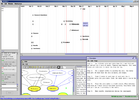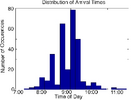







A proactive display is an application that selects content to display based on the set of users who have been detected nearby. For example, the Ticket2Talk [17] proactive display application presented content for users so that other people would know something about them.
It is our view that promising patterns for proactive display applications have been discovered, and now we face the need for frameworks to support the range of applications that are possible in this design space.
In this paper, we present the Proactive Display (ProD) Framework, which allows for the easy construction of proactive display applications. It allows a range of proactive display applications, including ones already in the literature. ProD also enlarges the design space of proactive display systems by allowing a variety of new applications that incorporate different views of social life and community.




Information cannot be found if it is not recorded. Existing rich graphical application approaches interfere with user input in many ways, forcing complex interactions to enter simple information, requiring complex cognition to decide where the data should be stored, and limiting the kind of information that can be entered to what can fit into specific applications' data models. Freeform text entry suffers from none of these limitations but produces data that is hard to retrieve or visualize. We describe the design and implementation of Jourknow, a system that aims to bridge these two modalities, supporting lightweight text entry and weightless context capture that produces enough structure to support rich interactive presentation and retrieval of the arbitrary information entered.
